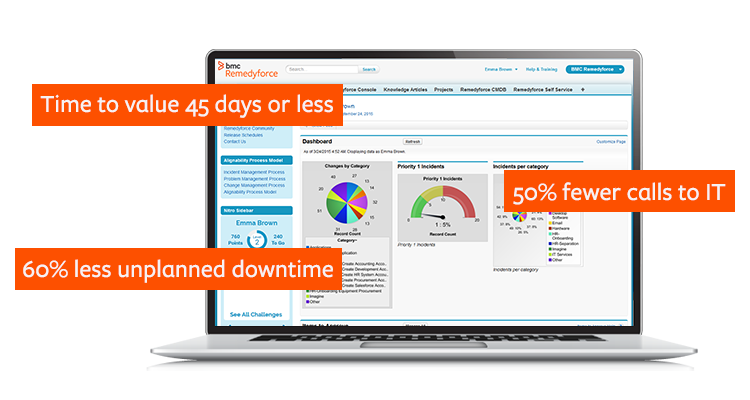In this Run and Reinvent podcast we chat with two guests from Cybera, a cloud-based managed network services provider: Brian Katsetos, vice president of operations, and Danny Sorenson, senior operations manager. John Fulton, principal product manager here at BMC, leads the discussion on how Cybera is using BMC Helix Remedyforce to transform its IT service management practice into an award-winning operation. Below is a condensed transcript of the conversation.
John Fulton: You guys are growing globally, how is that posing challenges for you?
Brian Katsetos: From a support perspective, our C shift we really redefine our processes when going global because what used to be third shift is now our C shift is someone’s first shift, and so we really had to put the paradigm that we are always someone’s first shift, 24/7 365. And redefining those processes, we really had to take a look at the tool sets that we’ve had to use and staying nimble and agile, especially from a service delivery perspective, can be quite challenging if you don’t have the right tools in place.
And for us, in the very beginning of our maturation process, that’s one that we faced quite frequently off the bat. And so, really looking at it from that global perspective, you really had to define and rework processes, tool sets, even different levels of service delivery methods, thinking more globally for us is one of those things that before this growth that we’ve had, really wasn’t on our radar. It was on the horizon, but we’ve grown so rapidly that it’s now forefront in our purview.
John: Can you give a characterization of your current environment? Maybe size of staff and servers to some extent?
Danny Sorenson: So, as far as the staff goes, the team is spread across three shifts. Going with specific numbers here would probably not be something I would care to do just because of the footprint that we cover, we do have to go across all the days of the year, so we’re careful about how we staff, and we’re able to now see trends of the work that we’re doing, thanks to the ticketing system that we have in place, whereas before, it was hard to do those kinds of things. So, we’re definitely able to go across that landscape and know this time of the year, how many pegs it takes to support what we have. What we’re trying to do in the space really support about 130,000 end points, I believe it is now, and so if that gives you kind of a scope in size.
John: Describe some of those challenges along your business goals that prompted you to look for a service desk solution?
Our original ticketing system that we used was pretty painful. It took a really long time to open a ticket. It took a really long time to close the ticket. And so, it was so painful, in fact, that what we realized was our techs were sometimes not documenting their work at all. Or they would open what they were calling a master ticket, and they would open it for each customer, and they would just had it across the shift, if you happened to get that specific customer, just add it to this ticket, that way you don’t have to go through the process.
With Remedyforce, we’re in real time able to start taking note immediately upon getting a phone call and open our tickets. That was one of the leading factors. Our onboarding process, the original ticketing system that we had was our longest learning curve. Our ticketing system now is our shortest learning curve.
John: With your prior system, any type of automation that supported that, or was it mainly manual through emails and manual tasks?
Brian: Yeah, it was a pretty manual process. We had a lot of challenges to deal with, with the previous system. With the advent of Remedy Force for us, the work flowing, the validation rules, the automation that comes with the tools set is an out-of-the-box standard, in most cases revolutionized how we handled support for our customer base. It also helped from an analytical perspective. We had questionable data and questionable metrics with our old system, and now we don’t question that.
We looked back two years ago, and now it’s a completely different focus for us. We’re not focused on, “Is the tool set going to handle it?” No, we’re focused on, “Okay, where do we go today? And where are we going tomorrow?” And so, that’s a great perspective for us to now have versus where we came from two years ago.
John: You’re using this with Salesforce. I would assume that this expands the view to other lines of business, for example the sales. Do sales have access to having that 360-degree view of the CRM case, versus the tickets and information like that? Is that something exposed today?
Brian: Yeah, absolutely. So, that was another area for us with the old platform. Data was just disjointed. You had to go to multiple systems to find what you were looking for. Now that we’ve got Remedyforce sitting on top of sales force for us, it’s opened up lines of communication throughout the whole entire business from a sales enablement perspective to just even a day to day communication perspective.
Our sales team loves the fact that we’re in this because before this, they did a lot of walking. They got their steps in. And now, they don’t have to worry about that so much. They can just go right into sales force, they can look at the tickets, they can look at the data, and they can pull the reports they need to, and it’s empowered them to move forward with the customer advocacy that they need and wanted to have on their own, without necessarily having to get deeply engaged with our team like they had to before.
John: Can you guys characterize how this implementing Remedy Force has changed your customer’s view of Cybera?
Brian: Yeah, absolutely. We can definitely answer that question. So, gaining the efficiencies that we have been able to gain by moving to Remedy Force, our reaction time has gotten better. The way we communicate with our customer base has gotten better. And it’s not an all-hand-on-deck scenario for us anymore to fulfil a customer request, whether it’s a support request, or a reporting request, change management request. It’s obviously improved our metrics. We report on our metrics to our focused accounts, and over the last two years, there has been a monumental improvement with our level of support, how we’re able to engage with our customer base. We can do that in a much more rapid pace.
John: How about internally from within your teams?
Brian: They love it. We actually noticed a, and this is just organically going from our old service management platform to our new one, somewhere between a 30 and 40% increase in productivity just by moving over to Remedy Force. Things are much more streamlined inside of the service management platform. It’s easier to ticket and document inside the service management platform. Our teams were hungry for the ease of use. And so, once we got them there, they almost didn’t know what to do with themselves, it was hard for them to believe it was just as easy to enter data into a ticket, and run a support call, and support our customers in this way.







